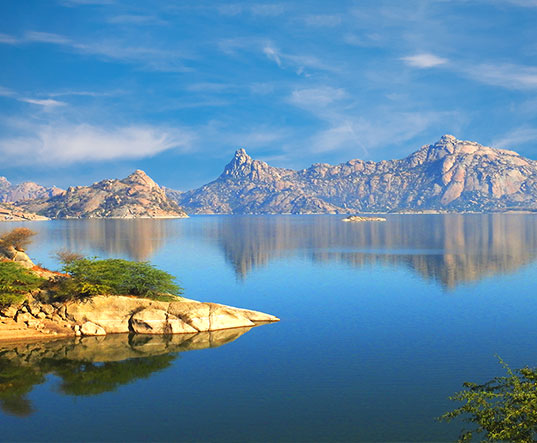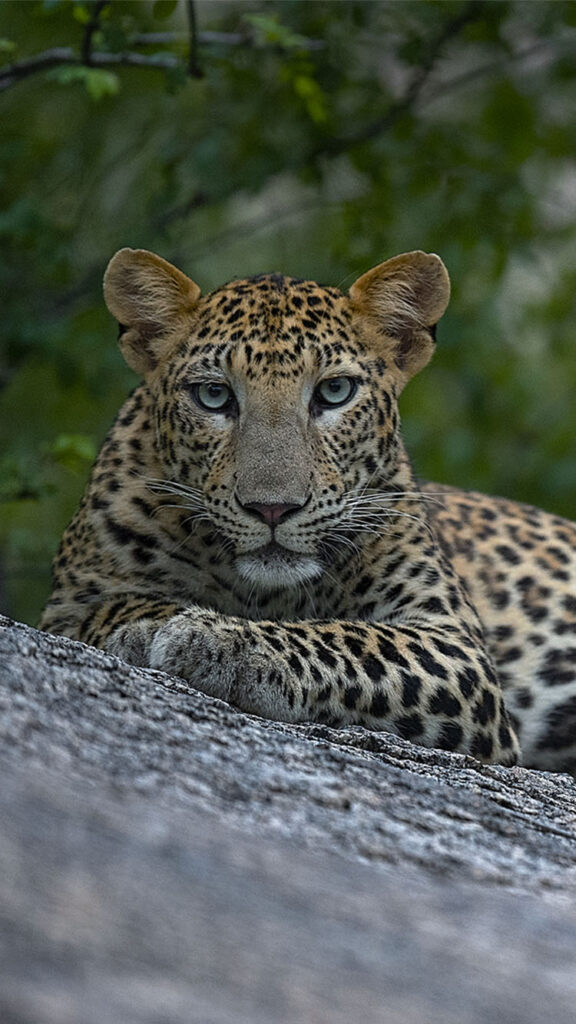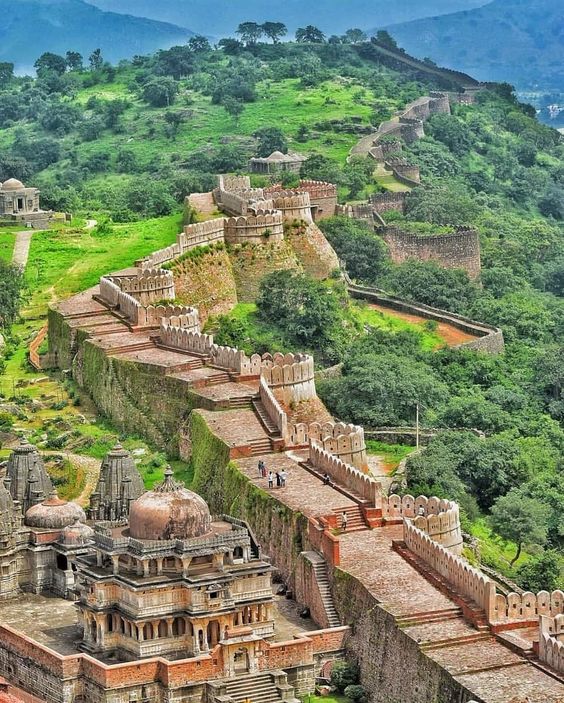


Kumbhalgarh, a majestic fort town nestled in the Aravalli Hills, is one of Rajasthan’s most iconic destinations. Known for its massive Kumbhalgarh Fort, the second-longest wall in the world, and its rich Rajput history, the town is a must-visit for heritage enthusiasts. But Kumbhalgarh’s allure doesn’t end with history. Just a short distance away lies the Jawai Leopard Sanctuary, a one-of-a-kind wildlife haven where you can spot leopards in their natural habitat while enjoying the breathtaking landscapes of rugged hills and serene water bodies. Together, these two destinations offer a perfect mix of culture, history, and adventure.
Kumbhalgarh Fort: A Marvel of Rajput Architecture
A UNESCO World Heritage Site, Kumbhalgarh Fort was built in the 15th century by Maharana Kumbha and stands as a testament to the architectural prowess and military strategy of the Rajputs.
Key Highlights of Kumbhalgarh Fort:
- The Great Wall of India: The fort’s 36-kilometer-long wall is second only to the Great Wall of China and is wide enough for eight horses to walk side by side.
- Badal Mahal: The “Palace of Clouds” is the highest point of the fort, offering stunning panoramic views of the surrounding hills and forests.
- Temples Inside the Fort: Kumbhalgarh houses 360 temples, including Jain and Hindu shrines, such as the Vedi Temple and Neelkanth Mahadev Temple, which are architectural and spiritual wonders.
- Sound and Light Show: Experience the rich history of Kumbhalgarh brought to life with mesmerizing visuals and storytelling every evening.
- Wildlife Surroundings: The fort is surrounded by the Kumbhalgarh Wildlife Sanctuary, home to wolves, leopards, sloth bears, and over 200 bird species.
Jawai Leopard Sanctuary: The Wild Heart of Rajasthan
Just 100 km from Kumbhalgarh lies Jawai Leopard Sanctuary, a unique destination that offers a perfect blend of wildlife and natural beauty. Known as the Leopard Capital of India, Jawai is the ultimate destination for wildlife enthusiasts and photographers.
What Makes Jawai Unique:
- High Leopard Sightings:
Unlike other wildlife reserves, Jawai has a high density of leopards, making it one of the best places to spot these elusive big cats. The rocky granite hills and caves provide an ideal habitat for them. - Coexistence of Humans and Leopards:
The local Rabari community has lived alongside leopards for generations. Their peaceful coexistence with the big cats is a remarkable example of harmony between humans and wildlife. - Scenic Beauty:
Jawai’s landscape is a mesmerizing mix of rugged granite hills, lush grasslands, and the serene Jawai Dam, which is a hub for birdwatching. - Diverse Wildlife:
Apart from leopards, Jawai is home to other species like sloth bears, hyenas, Indian wolves, jackals, crocodiles, and jungle cats. It’s also a haven for bird lovers, with flamingos, cranes, pelicans, and other migratory birds frequenting the area. - Leopard Safari:
The guided jeep safaris at Jawai are the highlight of any visit. The safaris are conducted during sunrise and sunset, offering the best chances of spotting leopards in action.
Activities in Kumbhalgarh and Jawai
In Kumbhalgarh:
- Trekking and Hiking:
The trails around Kumbhalgarh Fort and the Kumbhalgarh Wildlife Sanctuary are perfect for trekking and hiking. The sanctuary’s Jungle Safari takes you through dense forests where you can spot wolves, leopards, and exotic birds. - Exploring Ancient Temples:
Visit the numerous temples within the fort complex, including the Parshuram Mahadev Temple, which is located inside a cave. - Sound and Light Show:
Don’t miss the evening show at Kumbhalgarh Fort, which narrates the history of the Mewar kingdom in a captivating way.
In Jawai:
- Leopard Safari:
A guided safari through Jawai’s rugged terrain is the best way to experience its wildlife and natural beauty. The safari also includes visits to the caves where leopards live. - Birdwatching at Jawai Dam:
The dam attracts a variety of migratory birds, including flamingos, pelicans, and cranes. It’s a photographer’s paradise. - Luxury Camping:
Stay at one of the luxury camps in Jawai, where you can enjoy modern amenities amidst nature. These camps often include cultural evenings with traditional music and dance performances. - Hot Air Ballooning:
Experience the stunning landscapes of Jawai from above with a hot air balloon ride. - Cultural Tours:
Spend time with the Rabari herders to learn about their traditions, culture, and unique way of life.
Local Culture and Festivals
- Kumbhalgarh Festival: Held annually in December, this festival celebrates the cultural heritage of the region with folk music, dance performances, and art exhibitions.
- Rabari Cultural Experience in Jawai: Learn about the Rabari community’s traditional lifestyle, vibrant attire, and their harmonious relationship with nature and wildlife.
Nearby Attractions
- Ranakpur Jain Temple (50 km from Kumbhalgarh): A masterpiece of marble architecture and one of the most famous Jain temples in India.
- Jawai Bandh (Near Jawai Sanctuary): A massive dam surrounded by scenic beauty, ideal for birdwatching and picnics.
- Narlai: A small heritage village known for its stepwells, temples, and the Leopard Rock.
- Haldighati (45 km from Kumbhalgarh): A historic battlefield where Maharana Pratap fought against the Mughal army.
Best Time to Visit Kumbhalgarh and Jawai
The best time to visit is between October and March, when the weather is cool and pleasant, making it ideal for exploring the fort and wildlife safaris. The monsoon season (July to September) enhances the greenery and the scenic beauty of both destinations, but wildlife sightings might be less frequent.
How to Reach
- By Air:
- The nearest airport is Maharana Pratap Airport, Udaipur (85 km from Kumbhalgarh and 150 km from Jawai).
- By Train:
- The closest railway stations are Falna and Jawai Bandh, both well-connected to major cities in Rajasthan and beyond.
- By Road:
- Both Kumbhalgarh and Jawai are easily accessible by road. Private taxis and buses operate regularly from Udaipur, Jodhpur, and other nearby cities.
Accommodation Options
In Kumbhalgarh:
- Luxury: The Aodhi, Ramada Resort by Wyndham
- Mid-Range: Fateh Safari Lodge, Kumbhalgarh Forest Retreat
- Budget: Jungle Lodge, Hotel Rajgarh
In Jawai:
- Luxury: SUJÁN Jawai, Jawai Leopard Camp
- Mid-Range: Varawal Leopard Camp, Thour Nature Resort
- Budget: Leopard Hills Stay, Jawai Nature Stay
Why Visit Kumbhalgarh and Jawai?
Kumbhalgarh offers a glimpse into the rich history and architectural brilliance of Rajasthan, while Jawai Leopard Sanctuary provides an exhilarating wildlife experience. Whether it’s exploring the fort’s massive walls, trekking through wildlife sanctuaries, spotting leopards in Jawai, or relaxing in luxury camps, these destinations together promise an unforgettable adventure.
Conclusion
Kumbhalgarh and Jawai Leopard Sanctuary offer the perfect blend of history, culture, and wildlife. From the towering fort walls of Kumbhalgarh to the thrilling safaris of Jawai, this region promises something for everyone. Plan your trip with TripToRajasthan.com and explore these hidden gems of Rajasthan like never before!
